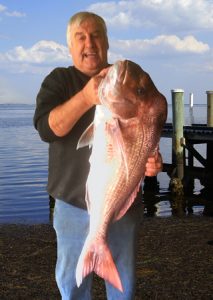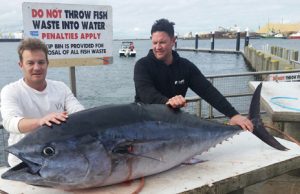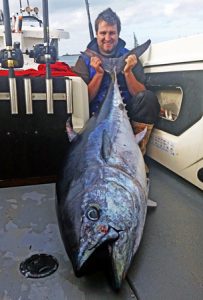
Graham Bate with the 9.7 kg snapper that he caught from Corio Bay last week.
Corio Bay/Bellarine Peninsula
Making an early start on Corio Bay last week, Graham Bate of Lara was soon soaking pilchards offshore from the Mountain View Quarries, hopeful of catching a snapper: No problem there, and at 9.7 kg it was the biggest he’d ever caught.
Freshwater
John Clements of the Lake Purrumbete Holiday Park reports that trophy size brown trout are still on offer with Tim Beusman adding yet another big one to his tally at 4.5 kg. He caught that one while casting a bibbed minnow-type lure into likely-looking areas.
Joe Rundle also caught a brown trout of 1.5 kg, while Stan Rae and Josh Fraser, both of Norlane, each took good catches of redfin: Josh also caught a respectable brook trout while fishing a mudeye under a float.
John also mentions that nearby Lake Bullen Merri has been fishing well, both for anglers in boats, and for those fishing from the bank.
Among the recently successful anglers here were Bruno Portaro and Geelong’s “Budgie Bryant”, who – along with a good many others –caught both rainbow trout and chinook salmon to 2 kg, both on baits like pilchard fillets, and on various lures.

Steve Prior and Jacob Mills with the 118 kg tuna they caught off Port MacDonnell on Saturday (Picture: Bob McPherson).
Portland
Down Portland way, Bob McPherson reports that large tuna are still about and among those to catch them were Adrian Mills and Greg Ruder who picked up a 104 kg fish in 70 metres of water off the Cape Nelson lighthouse while returning from Cape Bridgewater on Friday.
Over the border at Port MacDonnell, Steve Prier and Jacob Mills hooked two large tuna, of which they caught one of 118 kg after pulling the hook on the other.
The inshore fishing at Portland has also shown promise for whiting, said Bob, with Hugh and Ben Johnstone both taking respectable catches in front of the Maretimo Homestead gates.

Adrian Ryan with the 104 kg tuna that he and Greg Ruder caught off Cape Nelson on Friday (Picture: Bob McPherson).
Prospects
Now on the cusp of spring, and hopefully better weather than we’ve experienced of late, the fishing should also improve. Here are some prospects:
With northerly winds predicted for Friday and Saturday, the new Portarlington Breakwater should be a prime spot for land based snapper fishing, particularly while the water remains discoloured: Likewise the St Leonards Pier; but only for those athletic enough to climb down and subdue fish from the rocks below.
A fish that some of we more senior anglers used to catch in spring – but which receives little attention nowadays – is snook, which we used to call pike back then, and which are still usually abundant in Spring.
Fishing at dawn or dusk offers the best prospects, particularly while casting bibbed lures from the rocks at North Shore, but only when low tide permits access at those times.
Prior to that, I learned the art of catching them on pilchards rigged on a flight of ganged hooks from a Mr Page from the old Parkside swimming pool. Unfortunately though, that structure was demolished on orders from the Geelong City Council some years ago now, and never replaced. However, some of the small jetties like Rippleside, and other structures like the original Limeburners breakwater, should provide similar opportunities.
Conrad asks:
Geoff; are the snapper currently being caught in Corio Bay newly arrived fish through Port Phillip Heads, or are they resident fish?
Conrad, historically speaking, since we have always seen in increase in snapper activity from Corio Bay as the water temperature begins to rise in August; I believe that these are fish that have been present in the bay throughout winter, something that is usually indicated by an increased amount of fat inside the body cavity.
A popular belief, and one that is probably right, is that snapper enter Port Phillip when the Bay’s internal temperature is equal to that outside The Heads. The present temperature in southern Port Phillip is currently 13 degrees Celsius, which is only half a degree cooler that the water outside; a process you can follow at http://www.baywx.com.au/temps.html
So, more than likely, the first influx of snapper from outside the Bay will begin within a week or so; the first sign being the seals initial success at ambushing the first of these initially unwary fish and eating them at the surface for all to see.
